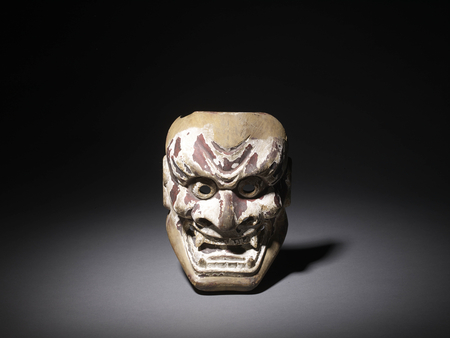Product Description
7328 A painted wood Kagura theatre men (mask) of the Shinto deity Tajikara no o Mikoto.
Iscribed: Kishin Kawachi Daimyōjin Gosho Daimyōjin tōson Aikawa Tōjirō (Donated by Aikawa Tōjirō, to Kawachi Daimyōjin shrine and Gosho Daimyōjin shrine. A resident of this village)
Japan 15th /16th century Muromachi period
Dimensions: H. 8½” x W.6¼” x D. 4¼” (21cm x 15.5cm x 10.5cm)
Kagura (lit. god-entertainment) refers to a specific type of Shinto theatrical dance predating Noh theatre which has gradually evolved over a millennium. Once strictly a ceremonial art derived from kami gakari (oracular divination) and chinkon (spirit pacification) it is still very much a living tradition, with rituals tied to the rhythms of the agricultural calendar thriving primarily in parts of Shimane prefecture, and urban centres such as Hiroshima.
In the ancient texts of Kojiki and Nihonshoki, there is a famous legend describing the origin of Kagura among traditional Japanese dance. This tale refers to the sun goddess Amaterasu, who retreated into a cave and vowed never to show herself again when her brother the storm god Susanowo-no-Mikoto left his home on the seas and began to ravage the land.
Without her light the world fell into darkness and devils sprang from their hiding places to roam freely across the earth in its endless night. Knowing that all life was doomed without Ameterasu, the gods of heaven and earth gathered at the cave’s mouth and begged her to reappear but to no avail and all creation seemed doomed.
Finally, Ame-no-Uzume-no-Mikoto, a small goddess with a face creased by age and laughter declared that she would coax Ameterasu from the cave. The mightier gods looked at the old woman and sneered. Ame-no-Uzume-no-Mikoto smiled back at them, poured out a huge sake barrel, jumped on its head and began a wild dance.
The loud and frenetic pounding of her feet made a sound unlike any ever heard before. The rhythm was so infectious that soon the other gods began to dance and sing along. Music filled the earth and the celebration became so raucous that Ameterasu filled with curiosity peeked out from her cave and seeing the joyful faces brought her light to the earth again. Thus Ameterasu’s light returned to earth and Susanowo-no-Mikoto was banished. Tajikara no o Mikoto, the god of sports and physical power represented in this mask assisted Amaterasu out of her cave.
Kagura is one of a number of rituals and performing arts said to derive from this event.
Originally Kagura began as sacred dances performed at the Imperial court by miko (shrine maidens) said to be descendants of Ame-no-Uzume. Over time these performances within the sacred and private precincts of the Imperial courts, inspired popular ritual dances practiced in villages all around the country and were adapted into various other folk traditions which developed into a number of different forms.








